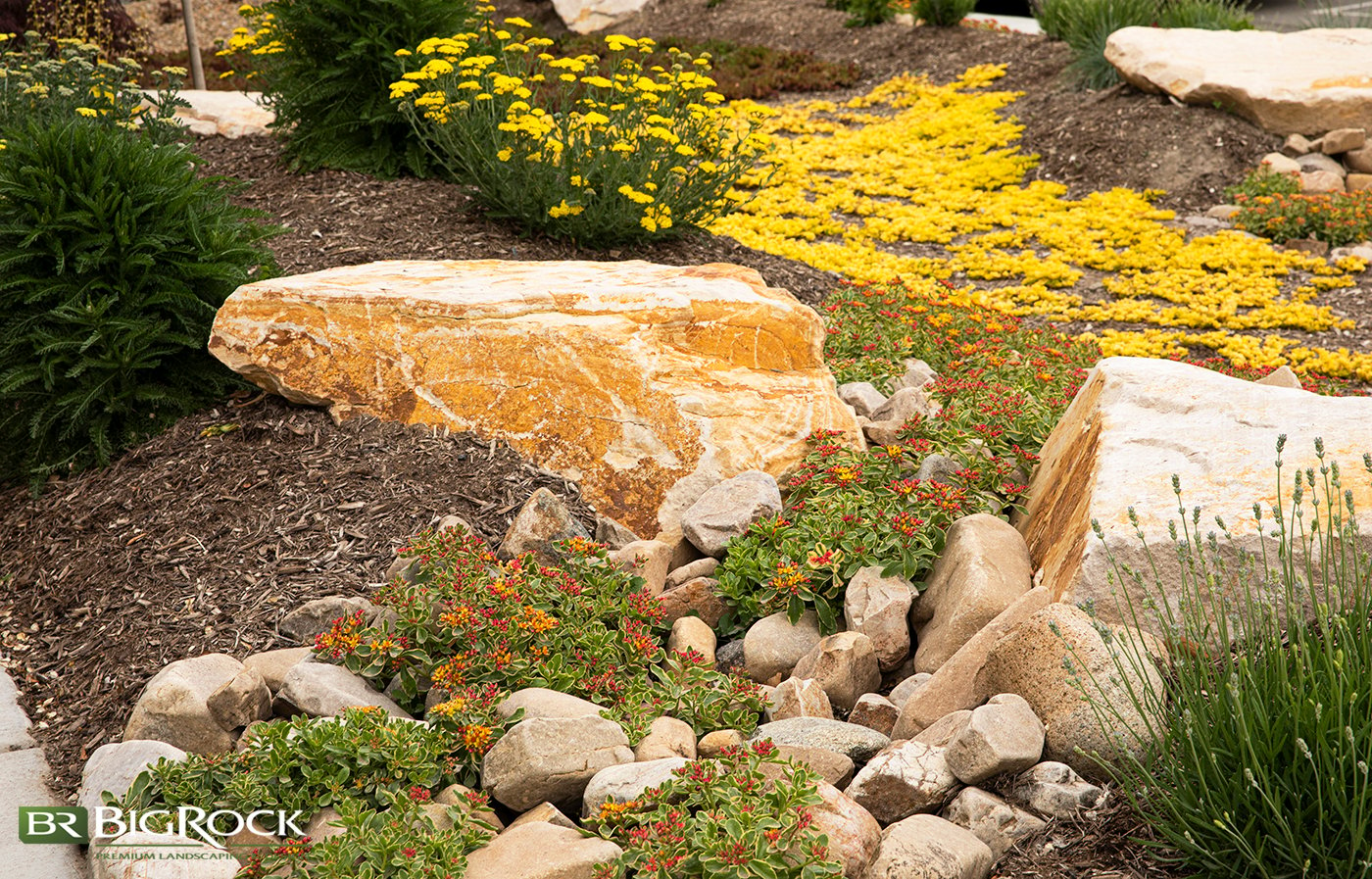
5 Drought Resistant Parking Strip Ideas
As pretty as green parking strips are in the spring or rainy seasons, you may be tempted to convert them to hardscaping when water is scarce and the grass starts to die in the dead of summer. However, we’re here to warn you that drastically changing your parking strip design out of frustration is similar to a girl cutting bangs after a break up—a change sounds nice, and it seems like a good idea, but in the end, you’ll likely regret it and be stuck redoing it or living with your decision. Instead of tearing it out altogether, consider doing a parking strip makeover using some of our drought resistant parking strip ideas. Not only will they help you reduce the amount of water you use each year, but they can really enhance the look of your front yard too.
Before You Remodel Your Parking Strip
In many areas, parking strips are a narrow piece of land between the sidewalk and the street that exists as a place to run public utilities. But aside from the practical use of parking strips, they can also be beautiful additions to neighborhoods as they set the houses further back from the street, add extra greenery, and make the streets feel wider. On the other hand, in some areas, parking strips are referred to as “hellstrips.” This nickname no doubt comes from the maintenance headaches they can cause.
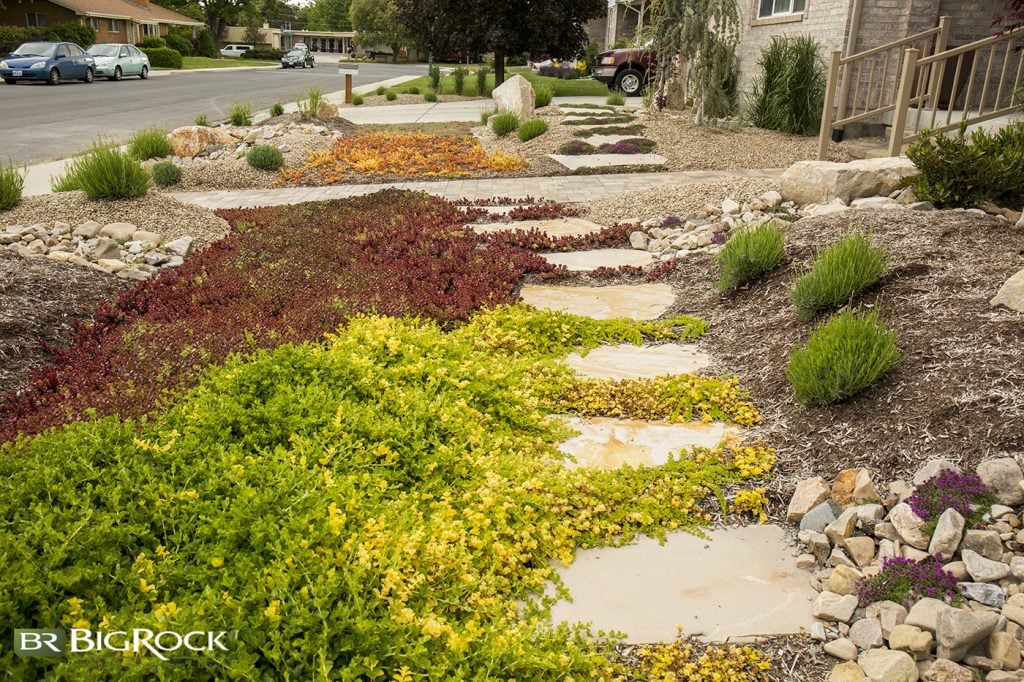
When was the last time you paid any attention to your parking strip? If you’re ready for some fresh parking strip landscaping ideas, we’ve got you covered—especially when it comes to drought resistant parking strip ideas. But before you put on your work gloves and grab your shovel, here are a few things you should consider.
1. City And HOA Regulations
Before you make a plan, the first thing you should do is check with the city to see if there are any laws or regulations around what you can or can’t do with your parking strip. If your neighborhood is part of an HOA, you’ll want to check with them too. Some areas have specific guidelines about the look of parking strips. Or you may find there are government programs or incentives you can use for your project. As part of this process, you’ll also want the utility companies to mark any gas, electric, or water lines you need to be aware of as you dig in the area.
2. Match Your Existing Landscaping
A xeriscape parking strip can look amazing, but if the rest of your yard is lush grass and plants, then it will make things look disjointed. If water conservation is the goal, you’ll want to select drought resistant parking strip ideas that flow with the rest of your yard. Your parking strip should match the rest of your landscaping so when you stand across the street, the parking strip, front yard, and house all look good together.
DISCOVER: Our Xeriscaping Portfolio
3. Plan Your Design
Review the existing infrastructure and make sure your parking strip landscaping ideas are consistent with the existing landscape. To create a solid vision of your parking strip transformation, consider sketching your goals and the materials listed to visualize the final outcome.
4. Know The Cost
A parking strip makeover is a small project in comparison with a full yard overhaul, so it’s tempting to just go for it without a budget. But even on small projects, we recommend setting a budget and pricing things out before getting started. This will help you know exactly what you can and can’t do.
5. Understand Maintenance Needs
Planning is key if you want to implement low maintenance parking strip ideas. Select plants and greenery that fit your desired maintenance levels. Know how often things will need to be watered so you can add an irrigation system if needed. Also make a plan for weekly, monthly, and yearly upkeep, as needed.
6. Safety First
Keeping people and animals safe should always be a priority. Whatever you choose to do with your parking strip, it should never block the flow of traffic on the street or sidewalk, and shouldn’t interfere with parking. You also need to be aware of tripping hazards, and make sure the plants you use aren’t poisonous for pets or people.
7. Get The Right Tools
Revamping your parking strip is a very public project, as you’ll be out in front of the house and close to the street. Therefore, you’ll likely want to get it done as quickly and efficiently as possible, to avoid too many disruptions to the neighborhood. Before you get started, make sure you have the right tools and supplies on hand. If you’re planning on doing concrete or paver work, you’ll need some heavy-duty gloves. If you are going to be planting anything, make sure you have a good soil rake and some hoses. You’ll also want to gather any and all plants, hardscaping materials, or specialty tools you will need to get the job done quickly and efficiently.
With a little bit of planning and effort, you can transform your parking strip into a beautiful, inviting, and water-wise space.
8. Hire A Professional
Because parking strips are narrow rectangles, they are easier to irrigate with an abundance of overspray which wastes money and water. Your parking strip must also withstand foot traffic, dog waste, and harsh conditions, as most parking strips get full sun. Although remodeling a parking strip might seem easy, it’s common for the average homeowner to make mistakes when attempting this home update.
Homeowners may forget to check with their local city about local regulations or specific rules about what you can and cannot plant or add to your parking strip and whether or not you need a permit, resulting in a hefty fine. They also sometimes forget to check for power lines, sewer, and water lines, irrigation pipes, or phone lines that may be buried underneath the parking strip before starting to dig, which can result in injury. If all this sounds like more of a hassle than you want to take on, consider hiring a landscaping professional like Big Rock Landscaping. Professional landscapers can take the headache out of any landscaping update and do the heavy lifting for you.
With a little bit of planning and effort, you can transform your parking strip into a beautiful, inviting, and water-wise space.
Why You Need A Drought Resistant Parking Strip
Even though they are small in area, parking strips can be a big burden on the water system in times of drought. That’s because sprinklers are often set up incorrectly so they overwater the parking strip, or water the street and sidewalk in the process. A drought resistant parking strip can have a big impact on the environment and help in times of drought. In fact, when it comes to drought-resistant landscaping, the parking strip is one of the most important areas to consider.
By selecting drought-resistant plants for your parking strip makeover, you can help conserve water and reduce your water bill. Additionally, drought-resistant plants are often native to the Utah area, so they require less maintenance and are better adapted to local conditions. A drought resistant parking strip can save you money and time, all while enhancing the look of your home.
Beyond those basics, here are 5 great reasons why you absolutely can’t live without a drought resistant parking strip:
Encourage Water Conservation
Drought-resistant parking strips are designed to thrive with minimal water requirements. By choosing drought-tolerant plants and implementing water-saving strategies, such as mulching and efficient irrigation systems, these strips can significantly reduce water consumption when compared to traditional landscaping.
Reduce Maintenance
Low-maintenance parking strip landscaping typically requires less attention, trimming, and pruning than water-intensive plants or grass. This saves time, effort, and resources in maintaining the parking strip, making it an ideal choice for busy areas or properties with limited resources for regular upkeep.
Improved Aesthetic
Many Xeriscape parking strips employ native plants with unique and attractive features, including vibrant flowers, interesting foliage, and unique textures. With careful planning and selection, a drought-resistant parking strip can enhance the area’s visual appeal and create an inviting environment.
Protect The Environment
Due to the harsh winter and summer climate in Utah, parking strip landscaping often includes drought-resistant plants that can withstand dry conditions and are often native or well-suited to the local climate. These native plants often have deep root systems to help stabilize and nourish the soil, designed to prevent runoff and erosion during storms or heavy rain. The plants’ roots act as natural anchors, reducing the risk of soil erosion and contributing to better water management.
Create A Natural Habitat
Xeriscape parking strip landscaping can provide a habitat for various pollinators, birds, and beneficial insects. These strips can contribute to the local biodiversity and support the conservation of native wildlife, creating a more sustainable and ecologically balanced environment.
Enjoy Long-Term Cost Savings
Property owners can save on their water bills by using drought-resistant plants that require less water and maintenance and reduce the need for additional landscaping services. Over time, these savings can add up significantly.
Creative Planting Ideas For Parking Strips
When it comes to creative planting ideas for parking strips, you can explore a variety of options to make the space visually appealing, functional, and sustainable. Here are some ideas to consider:
Low-water Native Plants
Design your parking strip with various drought-tolerant plants, succulents, and ornamental grasses. Combine different sizes and shapes of rocks to create an interesting and visually appealing landscape. Using rocks rather than mulch helps retain moisture and provide a naturalistic touch.
Ornamental Grasses
Incorporate ornamental grasses for their texture, movement, and low maintenance. Grasses, like fountain grass or switchgrass, are great for narrow parking strips and add visual interest by providing a soft, flowing aesthetic.
Succulents
Succulents are excellent choices for parking strips due to their ability to store water in their leaves. They come in various shapes, sizes, and colors, offering a striking and unique appearance. Consider species like agave, sedum, or echeveria for a visually appealing, drought-resistant display.
Flowering Perennials
Plan for a succession of blooms throughout the year by selecting plants with staggered flowering periods. This ensures that your parking strip remains vibrant and colorful during different seasons. Choose plants like daylilies, coneflowers, salvias, or daisies for a burst of seasonal color.
Edible Plants
Transform your parking strip into a functional and productive space by incorporating edible plants. Consider planting herbs, vegetables, or dwarf fruit trees, depending on the available space and sunlight conditions. This idea combines practicality with aesthetics.
Hardscape Design Options for Parking Strips
Hardscape elements can add structure, functionality, and visual interest to parking strip designs. Here’s how you can incorporate them effectively:
Walkways And Stepping Stones
Determine the desired flow and access points within the parking strip. Plan the walkways and stepping stones accordingly to create clear paths for pedestrians. Use concrete pavers, flagstones, or natural stone to create durable and visually appealing walkways. Consider different patterns and layouts to add interest.
Decorative Rocks
Decorative rocks can be strategically placed within the parking strip to add texture and visual contrast. Use them as focal points, to define certain areas, or as a stand-alone rock garden. Select rocks that complement the parking strip’s overall design aesthetic and size. Based on the desired effect, consider various types, such as river rocks, boulders, or gravel. You can also use rocks to create borders and edges between plants or combine different sizes and colors to create a pattern. Rocks can also serve as natural mulch, helping to retain moisture and suppress weed growth.
Permeable Paving
Permeable paving is an eco-friendly solution that can be particularly useful in parking strips to manage water efficiently. Permeable paving uses materials, such as concrete pavers, permeable asphalt, or porous gravel, with gaps or pores that allow water to pass through.
Seasonal Interest And Color In Parking Strip Landscaping
Consider your parking strip as an extension of your front yard landscaping. For the best results, use plants that create seasonal interest and provide a welcoming splash of color throughout the year. These are some of our favorite plant options that generally exhibit vibrant blooms and attractive foliage throughout the year in Utah:
- Penstemons are native perennials that come in various colors and bloom from spring to fall. They have tubular flowers and attractive foliage, making them popular in Utah gardens.
- Blanket Flower is a hardy perennial with daisy-like flowers that bloom from spring to fall. They come in vibrant colors like red, orange, and yellow, adding a splash of color to the landscape.
- Yarrow is a perennial plant with fern-like foliage and clusters of flat-topped flowers. They bloom in various colors, including white, pink, and yellow. Yarrow is drought-tolerant and attracts pollinators.
- Russian Sage is a woody perennial with silvery-gray foliage and tall spikes of purple-blue flowers. It blooms from mid-summer to fall and adds a touch of elegance to the garden.
- Autumn Joy Sedum is a popular perennial with succulent foliage and large clusters of pink flowers. It blooms in late summer and transitions to a coppery color in the fall, providing interest throughout the year.
- Butterfly bush is a deciduous shrub known for its long spikes of fragrant flowers that attract butterflies. It comes in various colors, including purple, pink, and white, and blooms from summer to fall.
- Blue flax is a native perennial with delicate blue flowers that bloom from late spring to early summer. It has slender, grass-like foliage and is well-suited for Utah’s dry conditions.
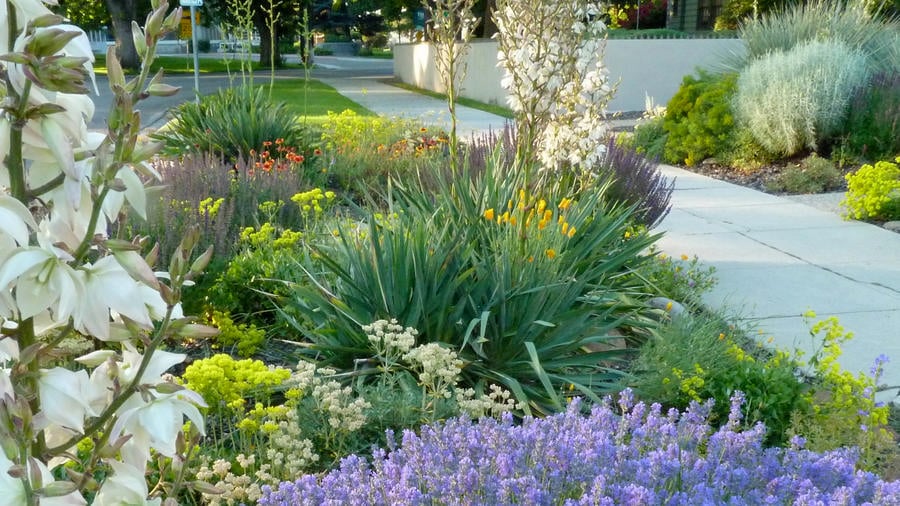
2. Add Low Shrubs Or Ground Cover
Juniper bushes, sumac, stonecrop, and more are all good options for low shrubs or ground cover. None of them need much water, and all do well in sunny areas. The low maintenance needed for these plants takes one thing off your to-do list.
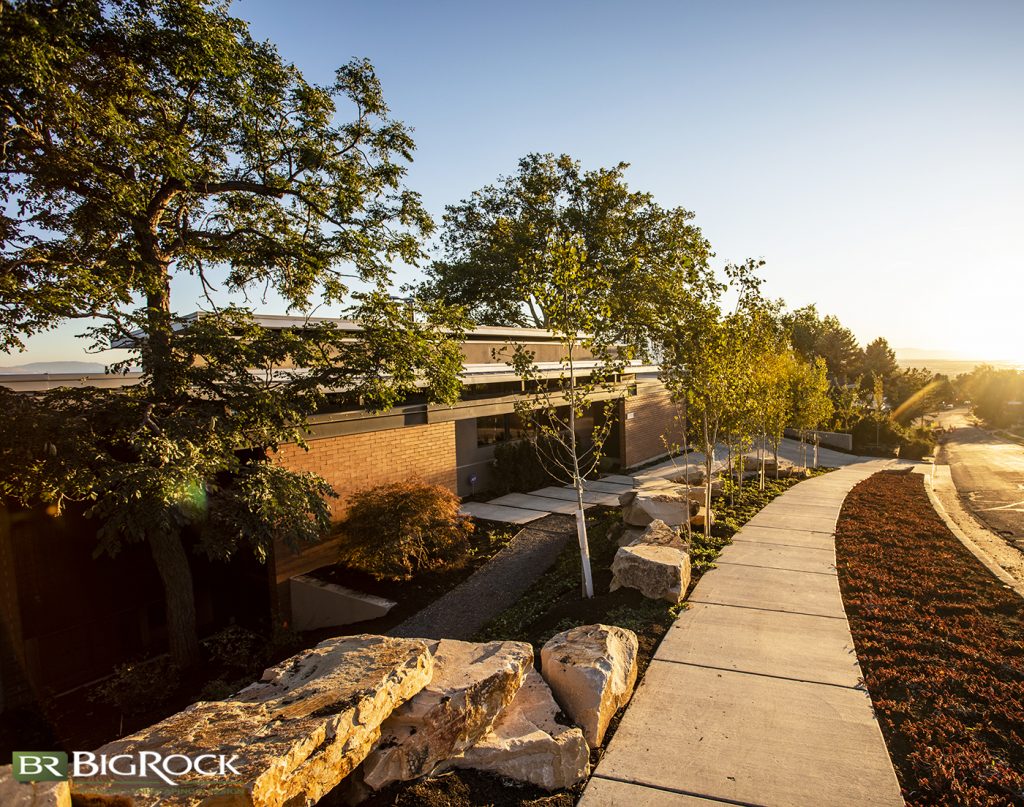
3. Mulch And Plant Perennials
Your planter beds don’t all have to be close to the house. Let the neighborhood get an up close look at your handiwork by using your parking strip as an additional planter area. Using native, waterwise perennials like lavender, will make the maintenance easy. Filling in blank spots with mulch will help keep even more moisture locked into the soil.
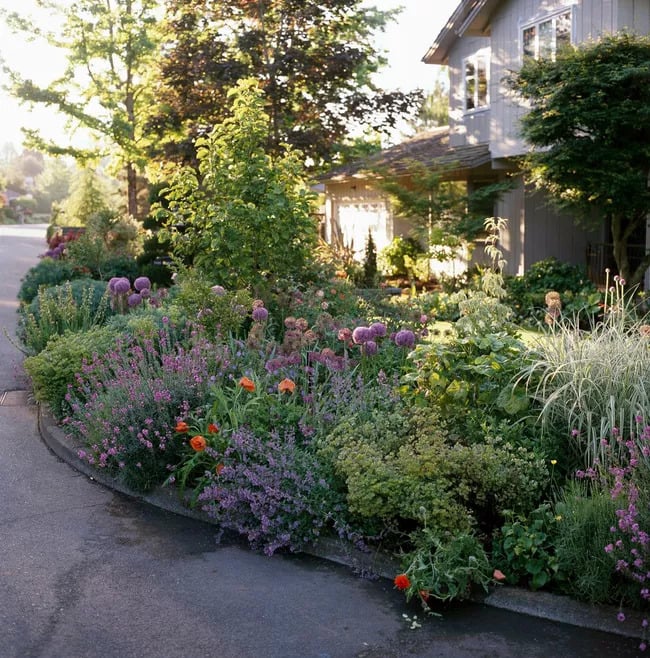
4. Xeriscape
There is a time and a place for xeriscaping. In fact, if xeriscaping is done well, it looks amazing! There’s more to the design than just throwing down some river rock and sprinkling in a few cacti. It’s more about strategically using native plants and foliage to create a wild and natural looking landscape that is low maintenance and water wise. A xeriscape parking strip is a great option if it makes sense with the rest of your landscaping. If you’re interested in xeriscaping your entire yard, here are some Utah xeriscaping ideas to get you started.
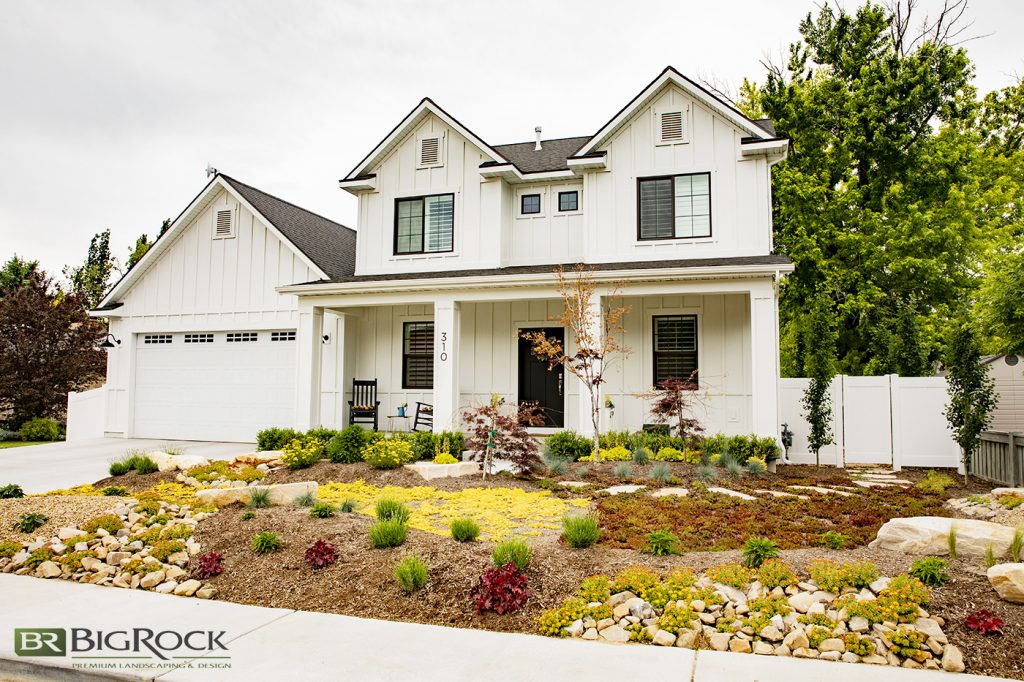
5. Add Pavers
Paver stones have the benefit of being more attractive than cement, but with the distinct advantage of requiring NO water. You can use patio paver stones in your entire parking strip, or mix natural or manmade pavers in with plants and other greenery for a low-maintenance, sustainable area.
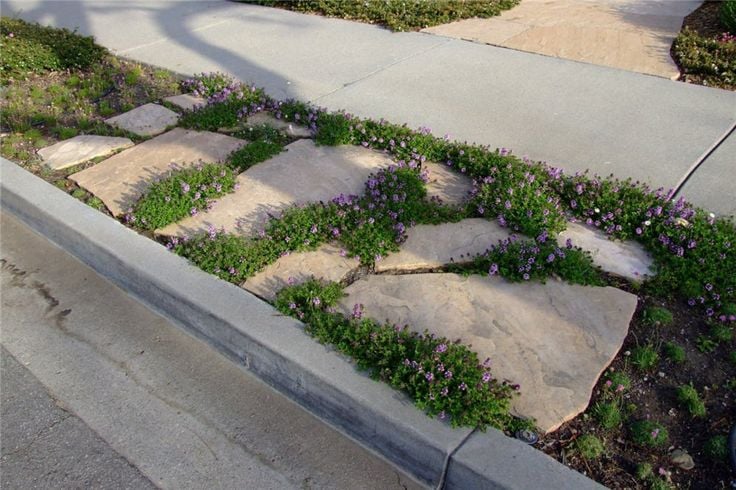
Have More Drought Questions About Your Yard?
If you’re tired of staring at your lawn and wondering what you can do for it during a drought, Big Rock Landscaping is here to help. In addition to these drought resistant parking strip ideas, we offer a wide range of the best landscaping services along the Wasatch Front. We can help you design, install, or retrofit your yard to be drought tolerant. With a water-wise yard, you won’t have to stress about it dying every time summer rolls around.
We have years of experience working with native Utah plants. We know what thrives in this climate, and can give you a yard that looks good now, and will continue to look good, even when water is scarce. Visit the Big Rock Landscaping services page, then give us a call to see what we can do for you.


Leave a Reply
You must be logged in to post a comment.